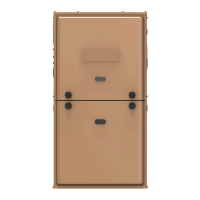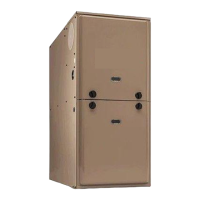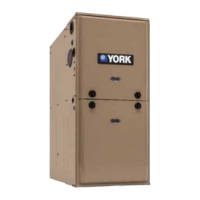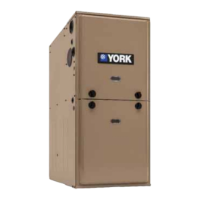Figure 24: Combustion air inducer
Category 1 - 450°F maximum vent
temperature
Install the venting system in accordance with Section 5.3,
Air for Combustion and Ventilation, of the National Fuel
Gas Code Z223.1/NFPA 54 (latest edition), or Sections
7.2, 7.3 or 7.4 of CSA B149.1, National Gas and Propane
Codes (latest edition) or applicable provisions of the local
building code and these instructions.
Connect the furnace to any type of B, BW, or L vent
connector and to a factory-built or masonry chimney. Do
not connect the furnace to a chimney flue serving a
separate appliance designed to burn solid fuel.
Install the appliance in a location where the space
temperature is 32°F (0°C) or higher. If installing the
appliance in a location where the ambient temperature
is below 32°F (0°C), the combustion byproducts could
condense, causing damage to the appliance heat
exchanger.
This appliance may be common-vented with another gas
appliance for residential installations as allowed by the
codes and standards listed in this manual.
Non-HUD approved modular homes must be vented with
an approved roof jack and may not be common-vented
with other appliances.
Venting
Category I venting consists of vertically venting one
or more appliances in a B-vent or masonry chimney
(as allowed), using single wall metal pipe or B-vent
connectors. A Type B-vent system extends in a general
vertical direction and does not contain offsets exceeding
45º. A vent system that does not have more than one 60º
offset is permitted.
Venting into an existing chimney
For Category I installations, the furnace is connected to a
factory-built chimney or vent complying with a recognized
standard, or a masonry or concrete chimney lined with a
material acceptable to the authority having jurisdiction.
Important: Do not vent this furnace into an unlined
masonry chimney or concrete chimney.
Where use of an existing chimney is unavoidable, you
must adhere to the following rules:
• The masonry chimney must be built and installed in
accordance with nationally recognized building codes
or standards and must be lined with approved fire-
clay tile flue-liners or other approved liner material
that resists corrosion, softening, or cracking from flue
gases.
Important: Do not vent this furnace into an
unlined masonry chimney.
• Only vent this furnace into a fire-clay tile-lined
masonry chimney if a source of dilution air is
available, such as by common venting with a draft
hood equipped water heater. If no source of dilution
air is available, you must use a Type B vent or
masonry chimney vent kit S1-1CK0604. Refer to the
instructions with the kit to correctly apply these
masonry chimney kits.
• The chimney must extend at least 3 ft (0.91 m) above
the highest point where it passes through a roof of
a building and at least 2 ft (0.61 m) higher than any
portion of the building with a horizontal distance of 10
ft (3.05 m).
• The chimney must extend at least 5 ft (1.52 m) above
the highest equipment draft hood or flue collar.
Fan-assisted combustion system
This appliance is equipped with an integral mechanical
means to draw products of combustion through the heat
exchanger.
Ambient combustion air supply
This type of installation will draw the air required for
combustion from within the space surrounding the
appliance and from areas or rooms adjacent to the space
surrounding the appliance. This may be from within the
space in a non-confined location or it may be brought
into the furnace area from outdoors through permanent
openings or ducts. A single, correctly sized pipe from the
furnace vent connector to the outdoors must be provided.
Combustion air is brought into the furnace through the
unit top panel opening.
Installation Manual: RL18 Single-Stage Standard ECM Residential Gas Furnaces (Non-condensing Multi-position Standard
Low NOx)
23
Johnson Controls Ducted Systems

